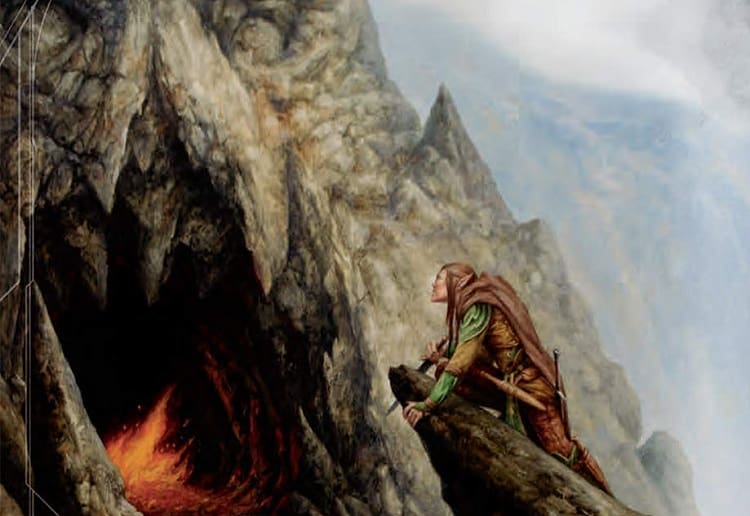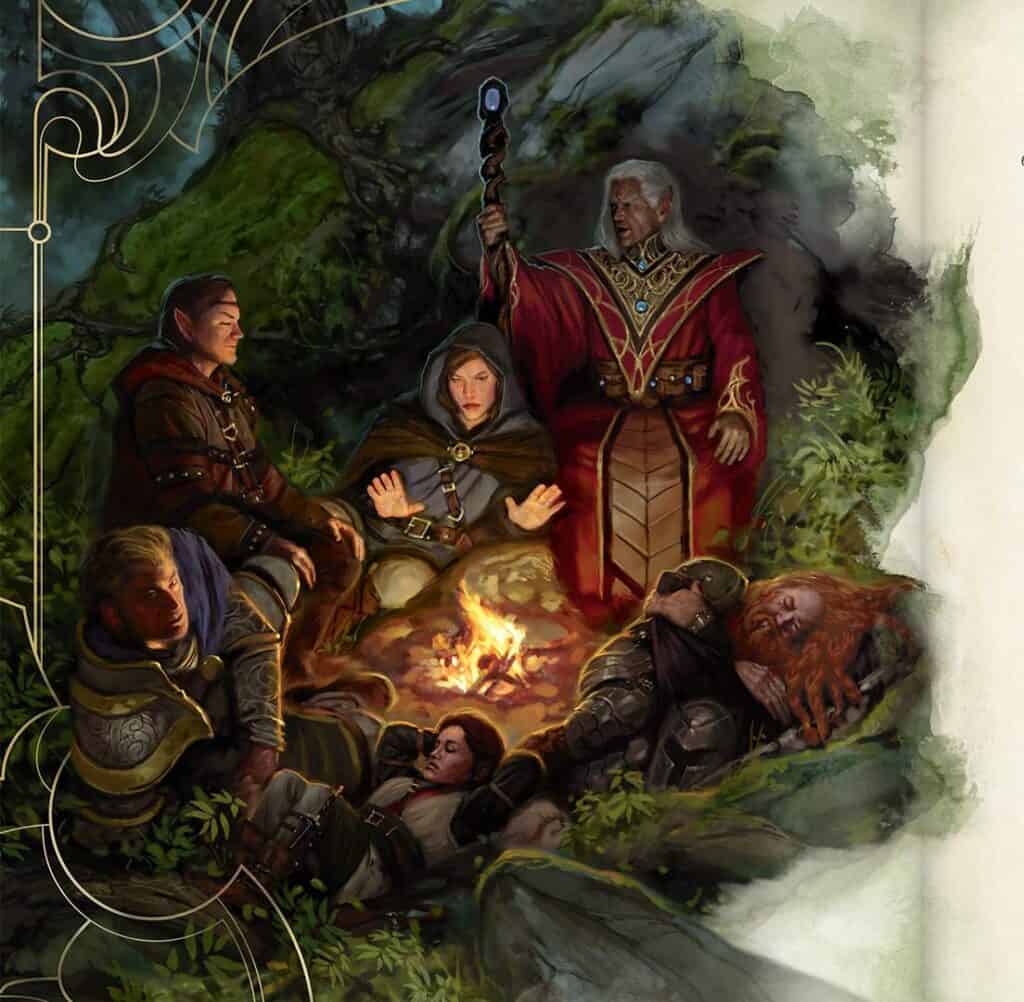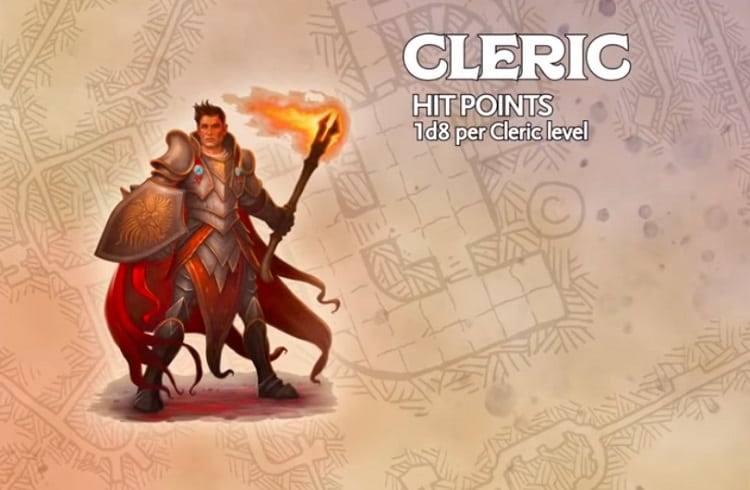Sacred Flame is not a powerful spell like fireball or fire bolt, however, it still packs a punch and might even illuminate your foes during a darker battle. It isn’t the most powerful cantrip that a cleric can use, but it does have some practical choices that can make it useful.
Still, many cleric players tend to dismiss this cantrip without even knowing about all that it can do. We hope to change a few minds with this Sacred Flame 5e guide, and hopefully get more clerics casting Sacred Flame!
What Is Sacred Flame?
According to the Players Handbook, here are the stats for Sacred Flame:
- Sacred Flame
- Cantrip Evocation
- Casting Time: 1 action
- Range: 60 feet
- Components: VS
- Duration: Instantaneous
- Classes: Cleric
Flame-like radiance descends on a creature that you can see within range. The target must succeed on a Dexterity saving throw or take 1d8 radiant damage. The target gains no benefit from cover for this saving throw.
The spell’s damage increases by 1d8 when you reach 5th level (2d8), 11th level (3d8), and 17th level (4d8).
Let’s break this spell down. First, it is a cantrip in the evocation class, and being a cantrip it does not take up a spell slot. There’s also no limit on when you can use it yourself, and it just takes one action. It has a range of 60 feet and you must have a line of sight to the target.
The radiant flame descends upon the creature and does 1d8 points of radiant damage, and unlike some spells in the game, this spell ignores cover and also is either a pass or a fail, so they either make the save or they take the damage. No half damage on a successful saving throw.
While 1d8 might not seem like a lot of damage, it does increase as you level up, so you can keep using this cantrip all throughout the game.
Is It Flame?

Despite having the words sacred flame in the title, the attack is not fire based. Instead, a pillar of radiant energy fire descends down on the target, and they either get out of the way or get hit by the attack.
The radiant damage also doesn’t do any extra damage to undead creatures, despite being radiant energy and being cast by a cleric and solely a cleric. In 5e, fire damage is much more likely to be resisted than radiant damage, so that’s certainly a benefit for you.
Is It An Attack?
It’s also not an attack as you don’t need to roll to hit with the spell, you merely announce that you are casting the spell at a target you can see within range, and then it automatically goes off.
Add spells are attacks, such as the firebolt spell where you roll to hit, and other spells require an attack. Booming Blade is a perfect example because a melee attack is part of the spell. Sacred Flame is not one of these spells, as it just needs a target to hit.
When To Use Sacred Flame
Sacred Flame doesn’t ever miss, which means that you can use this cantrip on two types of enemies, those with low dexterity and those with vulnerability to radiant damage. Enemies with low dexterity include big and slow creatures like zombies and giants, and most enemies do not have resistance to radiant damage.
Tactically, it’s a good spell that can be used to finish off hurt creatures, leaving your party to tackle new foes. Plus, with a range of 60 feet, you are able to stack the damage on one or multiple targets. Just keep casting the cantrip every single turn and you’ll get there with regards to the damage!
The only 5e beings that have resistance to radiant damage are angels, and nine times out of ten you are not encountering angels during a campaign. So you will at the very least get some guaranteed and non resisted damage when you cast this spell.
It can also be a good damage spell you can always fall back on whenever you run out of your regular spells, and having the ability to do regular spellcasting damage despite the saving throw whenever you are going through a dungeon can sometimes be a lifesaver.
Are Undead/Demons Vulnerable to Sacred Flame?

Even though it is being cast by a cleric, and the radiant world (as well as the natural resistance of angels to it) implies that there is some level of holy magic with regards to the spell, undead, and other demonic creatures are not vulnerable to or take extra damage from sacred flame.
The vulnerability of undead, fiends, and other demonic creatures changes a bit whenever you look at things like holy water. Holy water can be created by a cleric or paladin, and does 2d6 points of radiant damage to undead and fiends, but only those two types of creatures. Otherwise, you are just throwing a bottle at someone and it counts as an improvised weapon attack.
However, the one aspect where radiant damage could be useful when you are battling a vampire. Vampires have a skill where they regain 20 hit points at the beginning of every single turn, which is something your characters will have to hammer and slice their way through.
There are two ways you can negate this effect. The vampire’s regeneration can be stopped if they’re standing in sunlight or running water, or if they’ve taken radiant damage.
Since you will likely be at a higher level if you are matching wits with a vampire, your sacred flame will do more than 1d8 of damage, and you will have the extra effect of stopping the vampire’s regeneration for a turn along with the damage. Do keep in mind that vampires do have pretty high dexterity modifiers, so your party might need to find a way to weaken the vampire’s dexterity first.
Radiant Damage In 4th Edition
If you didn’t get started with 4th edition D&D, you might not know about all the rule changes and removals that were done to make the game more accessible for those playing 5th edition. One of those rules was the replacement of all holy damage with just radiant damage, and also 4th edition D&D made almost every undead vulnerable to radiant damage.
They would take double damage from all radiant spells, but after holy damage in 5e was introduced, the D&D rules were rewritten to separate radiant and holy damage. Monster vulnerabilities were also removed.
This was a rule change that most people disliked because it does make sense from a fantasy perspective. Zombies, undead, and other dark creatures should be vulnerable to holy light. This leads to the next question we could ask.
Can You Make Undead Vulnerable To Radiant Damage in 5e?
Giving undead monsters an extra vulnerability doesn’t mess with the game too much in terms of balance, as long as you play it right . If your game takes place where the party will be fighting a lot of undead, then naturally the party will lean more towards clerics and paladins. They might be doing the bulk of the radiant damage, but you can counter that.
Make the zombie or ghoul mob bigger by 1 or 2 monsters, or give the boss monster some extra hp to counteract the new vulnerability. As long as you buff the D&D monster encounters to balance out their new weakness, you will be fine.
Is Sacred Flame The Best Cantrip For Clerics?

It’s an all or nothing spell, it does low damage starting out, and it forces targets to use dexterity to dodge it. Despite these weaknesses, it does pretty solid damage, it is a cantrip that doesn’t cost a spell slot, and clerics can use it regardless of their alignment. However, how does it rank against some of the other damage dealing cantrips that you have access to?
Word Of Radiance is a cantrip released in Xanithar’s Guide To Everything, according to the book, the cantrip has this effect: “You utter a divine word, and burning radiance erupts from you. Each creature of your choice that you can see within range must succeed on a Constitution saving throw or take 1d6 radiant damage.
The spell’s damage increases by 1d6 when you reach 5th level (2d6), 11th level (3d6), and 17th level (4d6).”
Much like Sacred Flame, Word Of Radiance starts out at a low level with regards to damage. While the Sacred Flame targets one enemy, Word Of Radiance targets any creature of your choice within range. The problem is that the spell has a range of five feet and you will need to be close to the enemy for it to take effect. It might be a good spell if you want to be a melee focused cleric, but if you want to focus on spells you should be using Sacred Flame.
Still, if you aren’t using any of the supplemental books, which some DMs don’t then Sacred Flame is going to be your only damaging cantrip. In that case. It is the best cantrip in terms of damage.
Sacred Flame 5e Guide: FAQs
Question: How Can I Roleplay Sacred Flame?
If you are the type of person that likes to put a bit of fluff onto your spells, rather than saying ‘I cast sacred flame’ again and again, then you can easily roleplay a bit with a description.
Even if it isn’t an attack that is using fire, you can think of it as a beam of light coming from your hand. If the enemy you target makes a saving throw, then the beam misses. If it hits, you can describe the impact in several ways.
It could wreathe them in light, slam into them, deal burning damage, or any other effect that you can describe. It also has a verbal and somatic component, so your cleric can have a hand gesture or a word of power that they say whenever they cast the spell.
Play around with it, because if the sacred flame is your only damaging spell, you should make it worth your while to cast.
Question: Should I Use Sacred Flame Often?
Answer: If you are a Cleric and have sacred flame in your repertoire, then you might wonder how often you should use it. Of course, clerics have other spells, and unlike wizards or warlocks, the Sacred Flame cantrip doesn’t deal guaranteed damage like an Elderich blast would.
For the most part, your cleric should focus on topping off the HP of your allies with spells like healing word, and possibly doing melee damage if they are built for it.
Sacred flame can be good to use at higher levels, especially on slow creatures with a low hp pool, or on already bloodied enemies. However, unless you are saving your spell slots for a later combat encounter, it probably isn’t the best cantrip to use right off the bat.
Question: Can Your Enemies Use Sacred Flame?
If you find yourself battling clerics, either because they are evil or you are the evil ones, then they will certainly use sacred flame against you. Other than that, unless you are fighting clerics or enemies with the cleric template, you should be fine.
They can cast sacred flame on you, but most PCs tend to have very high dexterity modifiers, allowing you to make the saving throw to completely negate the damage.
Even if you end up falling the saving throw, it’s a d8 of damage for the 1st level caster all the way up to 4th level. Even with the increase at higher levels, you should have enough HP to weather a few D8’s of damage. If you don’t then you should have enough to heal from the damage after the fight.
Still, most of the time you aren’t crossing blades with clerics, so the chances of facing sacred flame yourself will be very low. That being said, it depends on the campaign and your DM’s choices.
- DnD Demons Guide: What Are Demons in 5e? - September 18, 2021
- Detect Thoughts 5e Guide: When, Why and How to Use It - September 9, 2021
- The Ultimate DnD Toll the Dead 5e Guide - September 9, 2021

